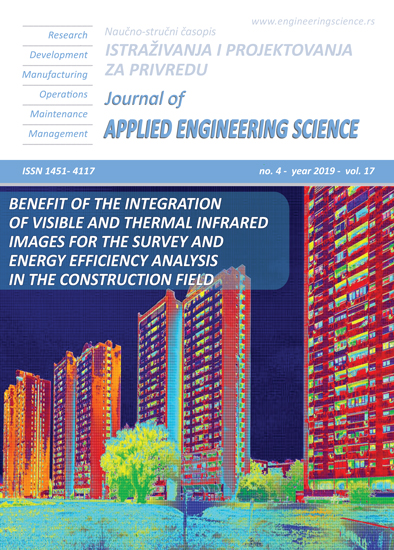BENEFIT OF THE INTEGRATION OF VISIBLE AND THERMAL INFRARED IMAGES FOR THE SURVEY AND ENERGY EFFICIENCY ANALYSIS IN THE CONSTRUCTION FIELD
Abstract
Infrared thermography is a non-invasive and non-contact technique that provides surface temperature distribution by measuring infrared radiation emitted by a body. The instrument that can determine the surface temperature of the object indicated is the thermal-camera. Nowadays, the use of thermal imaging is increasingly widespread and its application fields are numerous, especially in the construction environment. In this way, using a modern thermal-camera, it has showed in this paper the high performance of temperature map generated by these instruments. The integration of thermal camera with optical sensors allows to obtain, by a suitable methodology, a high quality of thermal image. Indeed, taking in account large building, it is impossible to cover the whole building and at the same time acquire with a high geometric resolution in relation to the modern thermal camera. In order to identify anomalies temperature on large and modern structure, a case study of the use of thermal images building is showed in the manuscript. Indeed, the knowledge of temperature distribution on the facade of the building provides very useful information to discover many hidden conditions related to the building performance, maintenance and energy efficient. Because the construction field accounts for 40% of energy demand in Europe, the use of thermal images in this environment provides an important contribute in the analyses process of temperature archived on the buildings.
References
Lerma, J. L., Mileto, C., Vegas, F., & Cabrelles, M. (2007, October). Visible and thermal IR documentation of a masonry brickwork building. In XXI International CIPA Symposium (pp. 01-06).
Zissis, G. J., & Wolfe, W. L. (1978). The infrared handbook. Infrared Information And Analysis Center Ann Arbor Mi.
Chrzanowski, K. (2010). Testing Thermal Imagers Practical Guidebook.
Usamentiaga, R., Venegas, P., Guerediaga, J., Vega, L., Molleda, J., & Bulnes, F. G. (2014). Infrared thermography for temperature measurement and non-destructive testing. Sensors, 14(7), 12305-12348. https://doi.org/10.3390/s140712305
Borrmann, D., Afzal, H., Elseberg, J., & Nüchter, A. (2012). Mutual calibration for 3D thermal mapping. IFAC Proceedings Volumes, 45(22), 605-610.
Oreifej, O. J., Cramer, A., Zakhor A. (2014). Automatic generation of 3d thermal maps of building interiors. ASHRAE transactions, 120, C1.
Scaioni, M., Rosina, E., L'Erario, A., & Dìaz-Vilariño, L. (2017). INTEGRATION OF INFRARED THERMOGRAPHY AND PHOTOGRAMMETRIC SURVEYING OF BUILT LANDSCAPE. International Archives of the Photogrammetry, Remote Sensing & Spatial Information Sciences, 42. https://doi.org/10.5194/isprs-archives-XLII-5-W1-153-2017
Maset, E., Fusiello, A., Crosilla, F., Toldo, R., & Zorzetto, D. (2017). Photogrammetric 3d Building Reconstruction from Thermal Images. ISPRS Annals of the Photogrammetry, Remote Sensing and Spatial Information Sciences, 4, 25.. https://10.5194/isprs-annals-IV-2-W3-25-2017
Quattrochi, D. A., & Luvall, J. C. (2009). Thermal remote sensing in Earth science research (pp. 64-78). SAGE Publications Ltd.: London, UK.
Jensen, J. R. (2007). Remote sensing of the environment: an earth resource perspective: Pearson Prentice Hall. Upper Saddle River, NJ.
Prakash, A. (2000). Thermal remote sensing: concepts, issues and applications. International Archives of Photogrammetry and Remote Sensing, 33(B1; PART 1), 239-243.
Reddy, M. A., & Reddy, A. (2008). Textbook of remote sensing and geographical information systems (p. 453). Hyderabad: BS publications.
Bergman, T. L., Incropera, F. P., DeWitt, D. P., & Lavine, A. S. (2011). Fundamentals of heat and mass transfer. John Wiley & Sons.
Fluke, Fluke Building Diagnostic Thermal Imagers, Datasheet. Available on line: http://www.myflukestore.com/pdfs/cache/www.myflukestore.com/fluke/thermal_imager/tir1_9hz/datasheet/fluke_tir1_9hz_thermal_imager_datasheet.pdf, 2017 (last accessed 19 November 2017).
Barreira, E., de Freitas, V. P., Delgado, J. M. P. Q., & Ramos, N. M. M. (2012). Thermography applications in the study of buildings hygrothermal behaviour. In Infrared Thermography. InTech. https://doi.org/10.5772/28282
Koretsky, G. M., Nicoll, J. F., & Taylor, M. S. (2013). A tutorial on electro-optical/infrared (EO/IR) theory and systems (No. IDA-D-4642). INSTITUTE FOR DEFENSE ANALYSES ALEXANDRIA VA.
Ball, M., & Pinkerton, H. (2006). Factors affecting the accuracy of thermal imaging cameras in volcanology. Journal of Geophysical Research: Solid Earth, 111(B11).https://doi.org/10.1029/2005JB003829
Luhmann, T., Robson, S., Kyle, S., & Boehm, J. (2013). Close-range photogrammetry and 3D imaging. Walter de Gruyter.
Pepe, M., & Parente, C. (2017). Cultural Heritage Documentation in Sis Environment: an application for" Porta Sirena" in the archaeological site of Paestum. International Archives of the Photogrammetry, Remote Sensing & Spatial Information Sciences, 42. https://doi.org/10.5194/isprs-archives-XLII-5-W1-427-2017.
Pepe, M., Fregonese, L., & Scaioni, M. (2018). Planning airborne photogrammetry and remote-sensing missions with modern platforms and sensors. European Journal of Remote Sensing, 51(1), 412-435.https://doi.org/10.1080/22797254.2018.1444945
Al-ISMAEIL, K. (2011). Structure from Motion & Camera Self-Calibration (Doctoral dissertation, Université de Bourgogne).
Fraser, C. (2015). Advances in Close-Range Photogrammetry, Photogrammetric Week'15.
Nunak, T., Rakrueangdet, K., Nunak, N., & Suesut, T. (2015, March). Thermal image resolution on angular emissivity measurements using infrared thermography. In Proceedings of the International MultiConference of Engineers and Computer Scientists (Vol. 1, pp. 18-20).
Lagüela, S., Armesto, J., Arias, P., & Herráez, J. (2012). Automation of thermographic 3D modelling through image fusion and image matching techniques. Automation in Construction, 27, 24-31.https://doi.org/10.1016/j.autcon.2012.05.011
Luhmann, T., Piechel, J., & Roelfs, T. (2013). Geometric calibration of thermographic cameras. In Thermal Infrared Remote Sensing (pp. 27-42). Springer, Dordrecht. https://doi.org/10.1007/978-94-007-6639-6_2
Rahmani, S., Strait, M., Merkurjev, D., Moeller, M., & Wittman, T. (2010). An adaptive IHS pan-sharpening method. IEEE Geoscience and Remote Sensing Letters, 7(4), 746-750. https://doi.org/10.1109/LGRS.2010.2046715
Pepe, M.& Parente, C. (2018). Burned Area Recognition by Change Detection Analysis Using Images Derived fromSentinel-2 Satellite: The Case Study of Sorrento Peninsula, Italy.Journal of Applied Engineering Science,16, 225–232. doi:10.5937/jaes16-18131
Parente, C., & Pepe, M. (2017). Influence of the weights in IHS and Brovey methods for pan-sharpening WorldView-3 satellite images. International Journal of Engineering & Technology, 6(3), 71-77. https://doi.org/10.14419/ijet.v6i3.7702

